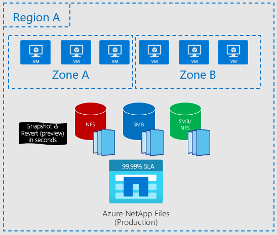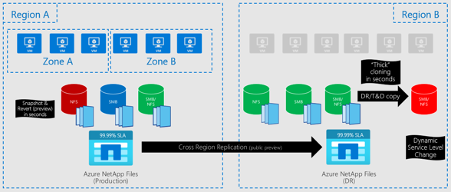Subscribe to our blog
Thanks for subscribing to the blog.
January 31, 2021
Topics: Azure NetApp Files AzureAdvanced5 minute read
If you and your company have demanding file workload requirements, the Azure NetApp Files service might save the day for you--as it has for many. Azure NetApp Files lets you move your NFS/SMB file-share workloads into Microsoft Azure – even your legacy applications – without rearchitecting applications. And it is secure. It provides private endpoints by design, so no public IP addresses are exposed when you access Azure NetApp Files volumes. ANF utilizes a networking layer developed for this service that dynamically injects the storage files from the underlying bare metal platform hardware directly into your virtual network at full line rate, with low datacenter level latency and with secure traffic isolation.
Azure NetApp Files is built on industry-leading, highly available NetApp® ONTAP® data management software. Microsoft Azure services are grouped in three categories: foundational, mainstream, and specialized services. Azure NetApp Files is in the specialized category, which is backed by specialized hardware and is already deployed in many regions. With built-in high-availability (HA) capabilities, Azure NetApp Files protects your data from most common outages, and offers you an industry-leading SLA of 99.99% uptime—that’s right, four nines.
High availability end-to-end
The Azure NetApp Files service has bare-metal fleets of nodes configured in HA pairs with RAID technologies. Dual Parity RAID gives you a high level of data protection and fault tolerance, protects your data against dual disk failures, bolsters fault tolerance, and lets you operate without disruption. If a node fails or a node needs routine maintenance, its partner takes over its functions. The partner node continues to serve data. The day is saved.
When a node returns to service, the partner node initiates giveback to return control to the original node. The hardware resilience of the bare-metal fleet comes from using multiple redundant components. If a redundant component fails, the surviving component lets you continue to get to your data. In that way, Azure NetApp Files stays available to you through almost anything.

Cross-region replication and disaster recovery
Although it’s rare, even an Azure data center can have an outage. When an outage occurs, it can cause a business disruption lasting minutes or even hours. One option is to wait for your service to come back online when the outage is over. Not fun, and not preferred by most. The Azure NetApp Files cross-region replication feature (currently in public preview) gives you a better option. The NetApp SnapMirror® feature of ONTAP is the disaster recovery (DR) technology behind the scenes.
With SnapMirror, you can fail over from a primary region to a secondary region (a geographically paired remote site). True to its name, SnapMirror creates a replica, or mirror, of your working data. With that mirrored data in your secondary region, you can continue to serve data, even if a catastrophe at the primary site.
SnapMirror gives you block-level replication, which mirrors all the NetApp Snapshot™ copies available in the primary volume. It is incremental. The target in the secondary region is available as a read-only copy at any time. But it can be made read/write accessible when the primary region fails.
The service level for the destination capacity pool can match that of the source capacity pool or you can select a lower service level. When there is a failover, you can dynamically change service levels to meet your needs. Because you replicate your data continuously in two or more places, you are ready for DR and uninterrupted development.
You can use your replication site as a backup, as a disaster recovery location, or as a clone of the dataset. You can also use it to create a set of clones and copies for use cases like user acceptance testing, DR simulation (while production replication continues), analytics, and new application development.

A summary of protective features
Azure NetApp Files gives you a combination of built-in high availability, RAID technologies, nondisruptive operations, Snapshot copies, cloud synchronization, and cross-region replication. That all adds up to fault tolerant, persistent storage in the cloud. If there is a disaster, your data is always protected. You can focus on your job, without worrying about the availability, security, and recoverability of your company’s cloud data and applications.
Key benefits
With all the features mentioned above, Azure NetApp Files is the ideal file storage for your most important applications. The benefits for you include:
- No need to rewrite applications. Each volume provides POSIX compliance shares that you need for many file-based workloads (file shares, SAP, high-performance computing, databases, Windows Virtual Desktop, Azure Kubernetes Service (AKS), analytics, and more). Those workloads can include web and rich media content, including content for specific industries (such as oil and gas, electronic design automation, media, and entertainment).
- Easily and quickly import data to and from on-premises storage and other storage repositories through NetApp Cloud Sync.
- Maintain business continuity with no data loss and with fast failover, short recovery times, and nondisruptive upgrade processes.
- Schedule tasks to meet the most demanding file share needs and benefit from security automation and orchestration capabilities.
To learn about solution architectures you can use with Azure NetApp Files, see the Azure NetApp Files documentation.
Summary
With the Azure NetApp Files service, Microsoft and NetApp bring to bear decades of experience in building enterprise NAS/SMB solutions. The service scales to meet the most demanding conditions. You get simultaneous access to hundreds of client hosts and applications. Even the largest enterprise is unlikely to be able to achieve comparable scalability on its own.
Getting Started
Azure NetApp Files provides rich features that help you to better manage your data with consistently high performance. To access this cloud-native file service and learn how easy it can be for you to manage, protect, and restore your file data, submit a waitlist request to access the service through the Azure NetApp Files waitlist submission page.